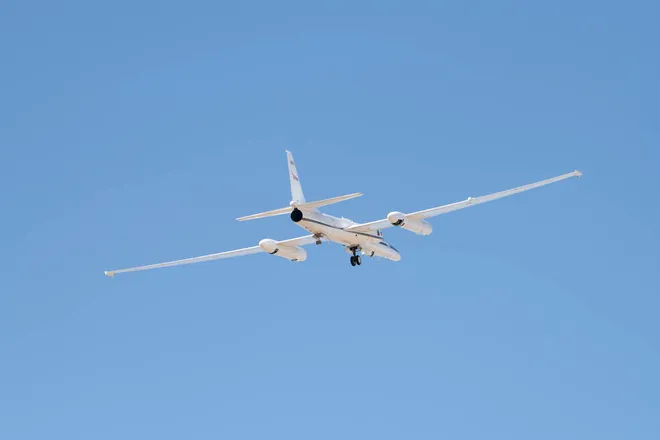NASA flew a spy plane into thunderstorms to help predict severe weather: How it works.

Storm-chasing NASA pilots recently spent weeks flying modified a spy plane directly into thunderstorms in an effort to gain new insights about lightning and severe weather.
Lightning has historically only been researched by low-flying aircraft or ground observers who are too far from thunderclouds to examine their detailed characteristics. Conversely, NASA's many satellites, such as the imaging sensor on the International Space Station, are attempting to measure lightning and related energy discharges from hundreds or even thousands of miles above.
But as the highest flying plane in the space agency's Airborne Science Program, the ER-2 aircraft was able to literally fly into the eye of the storm itself. The 60 hours of flight its pilots logged over the course of a month provided previously inaccessible observations that NASA hopes will help scientists better predict when storms could turn severe.
“This is a mission to go into the microphysics of what is going on in the enormous electric field above our heads,” principal investigator Nikolai Ostgaard from the University of Bergen said in a written statement.
To the moon and back:Astronauts get 1st look at Artemis II craft ahead of lunar mission
How often do lightning strikes occur?
About 40 million lightning strikes hit the ground in the United States each year, according to the Centers for Disease Control and Prevention.
The odds of being struck by lightning in a given year are less than one in a million, and almost 90% of all lightning strike victims survive, the CDC said.
Though it's rare that people are struck by lightning, the lingering threat is still a major cause of storm related deaths in the U.S. In the last three decades, the U.S. has averaged 43 reported lightning fatalities per year, according to the National Weather Service.
A lightning strike can result in a cardiac arrest, which can lead to irreversible brain damage for those who survive if they're not resuscitated in a timely manner, the weather service said.
How the experiment worked
Thunderstorms can emit two different types of gamma-ray radiation from their electric fields: terrestrial gamma-ray flashes and gamma-ray glows. While the flashes are brief (albeit intense) bursts of radiation that occur from specific points within the thundercloud, the glows are longer than the flashing and can last from minutes to hours.
In an effort to determine how long these glows last on average, an international group of scientists from the University of Bergen in Norway, the U.S. Naval Research Laboratory, and three NASA centers spent a month conducting and overseeing flights in thunderstorm hotspots.
With operations based in Tampa, Florida, researchers hoped to learn more about lightning and the vast energy fields around thunderclouds in Earth's atmosphere. As a result of their experiments, NASA said in a news release that researchers were able to capture the most detailed airborne analysis of gamma-rays and thunderclouds ever recorded.
The research was part of what's known as the ALOFT project, or Airborne Lightning Observatory for Fly’s Eye Simulator and Terrestrial Gamma Rays. The acronym may sound like a mouthful, but the mission was essentially to fly NASA's ER-2 aircraft above storms in Central America, the Caribbean, and off the coast of Florida.
The airplane is capable of flying at about 60,000 feet, an ideal altitude for flying in the proximity of thunderclouds. While airborne, the plane was fitted with instruments mounted on the aircraft to measure the brightness of gamma rays while flying as close as safely possible to thunderclouds as tall as 10 miles in altitude.
The ALOFT team on the ground was able to receive the data in real time, which allowed them to instruct pilots to circle and fly over any electrically glowing thundercloud detected for as long as possible.
The data collected allowed the team to understand more about under just what conditions terrestrial gamma-ray flashes are produced, as well as the behavior of gamma-ray glows in thunderclouds.
If that sounds hard to decipher, Timothy Lang, lead research aerospace technologist at NASA's Marshall Space Flight Center, put it this way: The data the program has gathered could "help scientists see when storms are strengthening and provide extra lead time of information to keep the public safe from the threat of lightning.”
'Internet apocalypse:'How NASA's solar-storm studies could help save the web
About the aircraft
The high-altitude Lockheed ER-2 aircraft used in the study is one of two NASA operates as "flying laboratories" based at the agency's Armstrong Flight Research Center in Palmdale, California.
The craft were acquired in 1981 and 1989 to replace two Lockheed U-2 aircraft that NASA was using since 1971 to collect science data, according to a NASA fact sheet about the aircraft. Combined, the U-2s and ER-2s have flown more than 4,500 data missions and test flights since the Airborne Science Program's inaugural flight in 1971.
An invaluable tool for scientific research, the craft have been used to study Earth's oceanic processes, make celestial observation and now, to study weather.
“It will open doors to understanding lightning," Ostgaard said. "We do not really understand how these gamma-ray flashes and glows are related to thunderclouds and lightning."
Eric Lagatta covers breaking and trending news for USA TODAY. Reach him at elagatta@gannett.com.
Disclaimer: The copyright of this article belongs to the original author. Reposting this article is solely for the purpose of information dissemination and does not constitute any investment advice. If there is any infringement, please contact us immediately. We will make corrections or deletions as necessary. Thank you.


